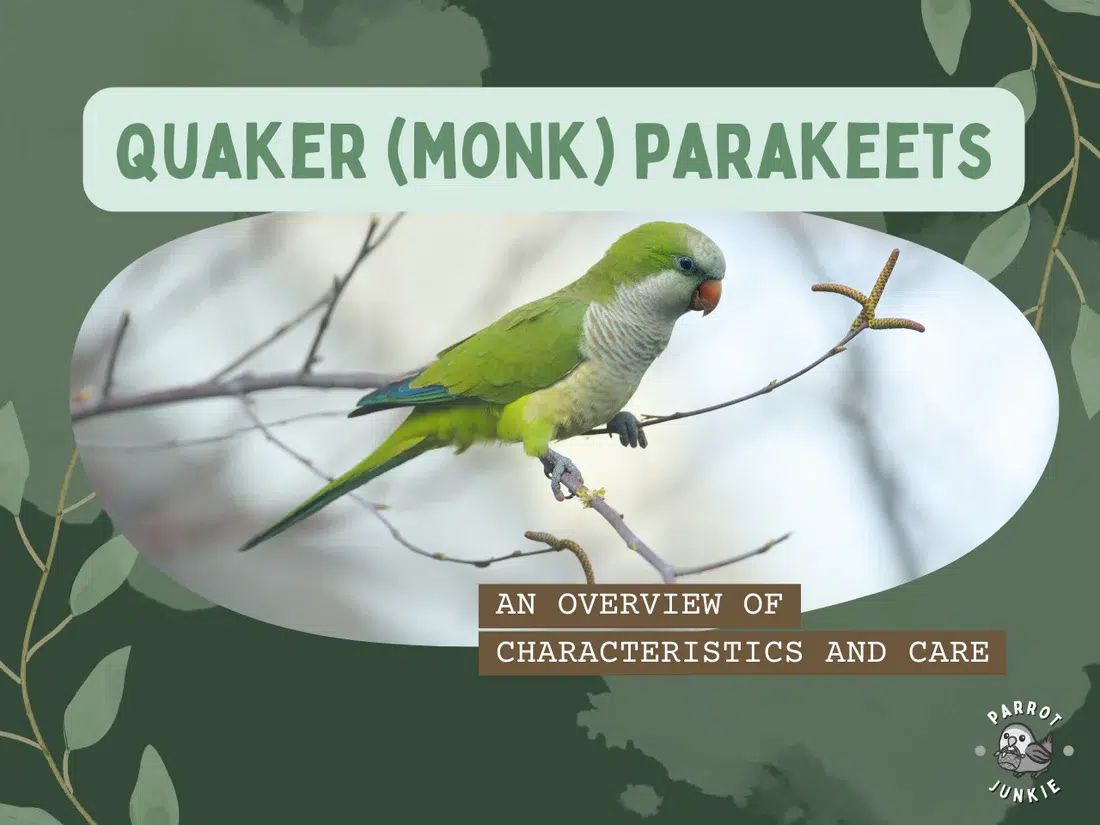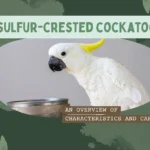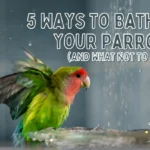
Quaker Parrots: An Overview of Characteristics and Care
Disclosure: As an Amazon Associate I earn from qualifying purchases. Some of the links below are affiliate links. This means that, at zero cost to you, I will earn an affiliate commission if you click through the link and finalize a purchase. Read more about this on this page.
Quaker parrots (Myiopsitta monachus), also known as Monk Parakeets, are small, vibrant birds that have captured the hearts of avian enthusiasts worldwide. Originating from a modest beginning in the South American wilds, these parrots have, over the years, spread across various continents, showcasing their remarkable adaptability. Known for their distinctive green plumage, playful nature, and exceptional talking abilities, Quaker parrots stand out as one of the most popular choices for pets among bird lovers.
However, there is much more to these charming birds than meets the eye. In this comprehensive guide, we will delve into the fascinating world of Quaker parrots, exploring their natural habitats, unique physical characteristics, intriguing behaviors, dietary needs, and much more. Whether you are a seasoned Quaker parrot keeper or just beginning to explore the possibility of adding one to your family, this article promises to provide you with insightful and essential information about these delightful creatures.
Jump To Section
Where Quaker Parrots Live In Nature
Quaker parrots, native to South America, exhibit a unique adaptability that has enabled them to thrive in various environments. Originally, these birds were primarily found in the temperate and subtropical regions of Argentina, Brazil, and Uruguay. However, their range has expanded significantly due to both accidental and intentional releases by humans.
In their natural habitat, Quaker parrots prefer areas that offer a balance of open spaces and dense foliage. They are commonly found in savannas, palm groves, scrublands, and along the edges of forests. These environments provide them with ample food sources, nesting opportunities, and the necessary cover from predators.
In countries where they have been introduced, Quaker parrots have shown remarkable resilience in adapting to local climates and ecosystems, sometimes even outcompeting native species. This has led to them being considered invasive in some regions, prompting management and control measures.
Quaker parrots have also adapted to urban environments. In cities, they are often seen nesting on buildings and utility poles, taking advantage of the warmth and shelter these structures offer. This adaptability to urban life has contributed to their successful colonization in various parts of the world, including the United States and Europe.
In their journey beyond their native lands, Quaker parrots have found new homes in various urban environments across the globe. In the United States, they are notably established in cities like New York, Chicago, and San Francisco, where they have become local avian celebrities, building large, communal nests on structures and in parks. Across the Atlantic, in Europe, countries like Spain and the UK have observed growing populations of these adaptable birds, particularly in metropolitan areas where their nests are a common sight. Down under in Australia, particularly in Sydney, Quaker parrots have also made their presence known, adapting to the local climate and urban landscape. Within Singapore, they are often spotted flocking in small groups in the eastern part of the island. These examples highlight the Quaker parrot’s incredible ability to thrive in diverse and often challenging urban environments, making them a unique example of wildlife adaptation in the face of human expansion.
The versatility in habitat preference of Quaker parrots is a testament to their remarkable adaptability and resilience, making them one of the few parrot species that have successfully expanded beyond their native range.
Physical Characteristics of Quaker Parrots
Quaker parrots are small to medium-sized parrots with a robust and distinctive appearance. On average, they measure about 11 to 12 inches (28 to 30 cm) in length from beak to tail, and they typically weigh between 90 to 120 grams. Their wingspan is relatively wide for their size, ranging from 18 to 20 inches (45 to 50 cm), which facilitates their agile and energetic flight.
One of the most striking features of Quaker parrots is their vibrant green plumage, which covers most of their body. The green is particularly bright and vivid on their backs and wings, while their undersides tend to be a lighter, more yellow-green hue. Their beaks are strong and curved, typical of parrot species, and are primarily used for cracking nuts and seeds.
The name “Quaker” in Quaker parrot is believed to have originated from their feather coloring and behavior. The grayish-white bib or frontal area on their chest resembles the old-fashioned Quaker attire, particularly the plain, gray, and white clothes historically worn by members of the Religious Society of Friends, commonly known as Quakers. This resemblance in their plumage led to the nickname “Quaker” parrot.
Additionally, some people also relate the name to the bird’s quaking or shaking behavior that it sometimes exhibits, especially when young or excited. This quaking movement, along with their distinctive plumage, collectively contributed to the name Quaker parrot.
Quaker parrots are also known for their expressive faces, with the ability to convey a range of emotions through their eyes and feather positioning. This expressiveness adds to their appeal as pets, as owners often feel a strong connection and ability to ‘read’ their bird’s mood and personality.
Sexual Dimorphism in Quaker Parrots
Regarding sexual dimorphism, Quaker parrots exhibit very subtle differences between males and females. These differences are often so slight that it can be challenging to determine the sex of a bird without genetic testing. Generally, males are thought to have a slightly larger and broader head, and their bodies may be a bit more robust, but these traits can vary and are not reliable indicators of sex.
Quaker Parrots’ Behavior and Personality
Quaker parrots are renowned for their vibrant personalities and engaging behaviors, making them a favorite among bird enthusiasts. These parrots are highly social, intelligent, and adaptable, traits that contribute to their unique behaviors and interactions with both their environment and human companions.
Social Nature: In the wild, Quaker parrots are known for their communal lifestyle. They often build large, intricate nests that can house multiple families, showcasing their cooperative nature. This social inclination also translates to their life in captivity, where they seek interaction and companionship, either with their human families or other birds.
Communication and Vocalization: Quaker parrots are exceptional mimics and are known for their ability to mimic human speech and a variety of sounds. This ability is not just a parlor trick; it reflects their high level of intelligence and desire for social interaction. They use vocalizations to express their emotions, from joy to frustration, making their care more engaging and sometimes challenging.
Playfulness and Energy: These birds are playful and active, requiring regular mental and physical stimulation. They enjoy a variety of toys and games and can often be seen swinging, climbing, and exploring their environment. This playfulness is a crucial aspect of their personality, and providing ample opportunities for play is essential for their well-being.
Bonding and Affection: When properly socialized, Quaker parrots can form strong bonds with their human caregivers. They are known for their affectionate behavior, which may include cuddling, gentle nibbling, and seeking out interaction. It’s important to note that they can become territorial and protective of their space and bonded human, which requires understanding and proper handling.
Intelligence and Trainability: Their high intelligence makes them highly trainable. They can learn a variety of tricks and commands, which not only provides mental stimulation but also strengthens the bond between the bird and its owner.
In summary, Quaker parrots’ behavior and personality are marked by their social nature, vocal abilities, playfulness, bonding capacity, and intelligence. Understanding and catering to these aspects are key to ensuring a happy and healthy life for these charming birds.
Quaker Parrots’ Dietary Requirements
Quaker parrots have specific dietary needs that are essential for their health and wellbeing. Understanding these requirements is crucial for anyone looking to care for these birds.
In the Wild: In their natural habitat, Quaker parrots have a diverse diet that includes a variety of seeds, fruits, berries, nuts, and vegetation. They are known to be opportunistic feeders, adapting their diet based on the availability of food sources in their environment. This diet provides them with a balance of nutrients, which is essential for their health.
In Captivity: When kept as pets, it’s important to replicate their natural diet as closely as possible to ensure they receive all the necessary nutrients. A balanced diet for a Quaker parrot should include:
- Pellets: High-quality commercial pellets should form the basis of their diet, as they are formulated to provide a balanced range of nutrients.
- Fruits and Vegetables: Fresh fruits and vegetables are crucial for providing vitamins and minerals. Safe options include apples, pears, carrots, broccoli, and leafy greens. These should be washed thoroughly to remove any pesticides or chemicals.
- Seeds and Nuts: While seeds and nuts are a part of their natural diet, they should be given in moderation in captivity due to their high-fat content. They can be used as treats or supplements to the main diet.
- Water: Fresh, clean water should always be available. It’s essential for hydration and overall health.
Special Considerations: It’s important to avoid foods that are harmful to Quaker parrots, such as chocolate, caffeine, avocado, and foods high in fat, salt, and sugar. Also, their diet should be varied to prevent boredom and ensure a range of nutrients.
A well-balanced diet is crucial for maintaining the health, feather quality, and longevity of Quaker parrots. Regular veterinary check-ups can help ensure that their dietary needs are being met effectively.
Housing and Environmental Needs
Cage Size and Setup
Adequate housing is crucial for the wellbeing of Quaker parrots. The cage should be as large as possible, ideally allowing the bird to fully extend its wings and fly short distances. A recommended minimum size is 24 inches (~60cm) wide, 24 inches (~60cm) deep, and 30 inches (~76cm) tall. The gaps between cage bars should be around 0.5 inches (~1.3cm) wide. The cage should be equipped with horizontal bars to facilitate climbing.
The interior of the cage should be outfitted with:
- Perches: Provide perches of varying diameters to promote foot health. Avoid placing them directly above food or water dishes to prevent contamination.
- Food and Water Dishes: These should be easily accessible and cleaned daily.
- Nesting Box: If breeding or providing a sense of security is a goal, include a nesting box.
- Safe Toys: Provide toys for mental stimulation and physical exercise. Rotate them regularly to keep the bird’s interest.
Toys and Mental Stimulation
Quaker parrots are intelligent and curious, requiring mental stimulation to prevent boredom and behavioral issues. Toys that encourage foraging, problem-solving, and physical activity are ideal. Include a variety of toys, such as chewable toys, and puzzles.
Light and Temperature
Quaker parrots thrive in a well-lit environment with access to natural sunlight, which is vital for vitamin D synthesis and overall health. However, direct sunlight can be harmful, so provide shaded areas in the cage. Maintain a comfortable and consistent temperature, ideally between 65-80°F (18-27°C), and avoid sudden temperature changes.
Environmental Safety
Ensure the bird’s environment is safe and free from hazards. This includes:
- Avoiding exposure to toxic fumes from cooking, smoking, or chemicals.
- Ensuring windows and doors are secure to prevent escape.
- Keeping other pets that may harm the bird away from its cage.
By providing a safe, stimulating, and comfortable environment, Quaker parrots can lead a healthy, active, and happy life.
Socialization and Interaction with Quaker Parrots
Socialization and interaction play a pivotal role in the wellbeing and happiness of Quaker parrots. These intelligent and sociable birds thrive on attention and engagement, both with their human families and, if available, with other birds.
Human Interaction: Regular, positive interaction with humans is essential for Quaker parrots. They enjoy being spoken to, played with, and simply spending time in the company of their owners. This interaction helps in building trust and a strong bond between the bird and its caregiver. Activities like talking to the parrot, teaching it tricks, and allowing it out of the cage in a safe environment for supervised exploration are excellent ways to interact.
Training: Quaker parrots are highly trainable, and this can be a great way to interact and bond with them. Training sessions should be short, positive, and consistent. They can learn a variety of tricks and commands, which also helps in managing their behavior.
Socialization with Other Birds: If possible, providing socialization opportunities with other birds can be beneficial, especially for a single Quaker parrot. However, this needs to be done cautiously, ensuring compatibility and gradually introducing them to each other to prevent aggression.
Recognizing Their Needs: Understanding and respecting the bird’s mood and needs is crucial. There will be times when the parrot wants to interact and times when it prefers to be alone. Paying attention to its body language and vocalizations can give insights into its mood.
Avoiding Negative Interactions: It’s important to avoid negative interactions such as yelling, punishment, or forcing interaction. These can lead to stress, fear, and behavioral issues in Quaker parrots.
By ensuring regular, positive interaction and socialization, Quaker parrots can develop into well-adjusted, happy pets, providing joy and companionship to their human families.
Quaker Parrots’ Health and Lifespan
The health and lifespan of Quaker parrots are directly influenced by their care, environment, and genetics. With proper care, these birds can live for 20 to 30 years, sometimes even longer, making them a long-term commitment for any pet owner.
Health Considerations:
- Diet: A balanced diet is crucial for preventing nutritional deficiencies and obesity, which can lead to health problems.
- Exercise: Regular exercise is essential for maintaining physical health and preventing obesity. This includes time out of the cage for flying and play.
- Mental Health: Mental stimulation is vital to prevent stress and behavioral issues such as feather plucking.
- Regular Check-ups: Routine veterinary check-ups are important for monitoring their health and catching any issues early.
Common Health Issues:
- Respiratory Problems: Quaker parrots can be prone to respiratory infections, often due to poor air quality or drafts.
- Feather Plucking: This can be a sign of stress, boredom, nutritional deficiencies, or health problems.
- Beak and Feather Disease: A viral disease that affects the feathers, beak, and immune system.
- Liver Disease: Often related to a high-fat diet.
Lifespan Factors: The lifespan of a Quaker parrot is influenced by several factors:
- Genetics: Like all species, genetics play a role in their overall health and longevity.
- Care and Environment: Quality of care, including diet, exercise, and mental stimulation, significantly impacts their lifespan.
- Stress Levels: High stress can lead to health issues, reducing their lifespan.
By understanding and meeting their health needs, Quaker parrot owners can ensure their feathered companions lead a long, healthy, and happy life.
Breeding and Reproduction of Quaker Parrots
Breeding Quaker parrots can be a rewarding experience, but it also requires careful consideration and planning. Understanding their breeding habits and requirements is essential for anyone interested in breeding these birds.
Breeding Age and Season:
- Quaker parrots typically reach sexual maturity between 1 and 2 years of age.
- The breeding season usually occurs once a year, often aligned with spring or early summer, depending on the region.
Nesting Behavior:
- In the wild, Quaker parrots are known for their unique nesting behavior, where they build large, communal nests from twigs and branches.
- In captivity, providing a suitable nesting box is important. The box should be large enough for the bird to move comfortably and add nesting materials.
Egg Laying and Incubation:
- A female Quaker parrot typically lays between 4 to 8 eggs per clutch.
- The incubation period is about 24 days, during which the female will spend most of her time on the nest.
- The male typically takes on the role of feeding and caring for the female during this time.
Raising the Chicks:
- Chicks are born altricial, meaning they are entirely dependent on their parents for warmth and food.
- Both parents usually participate in feeding the chicks.
- The chicks typically fledge (leave the nest) at about 6 weeks of age but may still depend on their parents for several weeks after.
Considerations for Breeding:
- Breeding Quaker parrots requires a commitment to providing ongoing care and ensuring the health and well-being of both the parents and the chicks.
- It’s important to be prepared for potential challenges, including health issues in chicks and the need for hand-rearing if the parents are unable to care for them.
- Responsible breeding practices are crucial, including ensuring genetic diversity and avoiding inbreeding.
Breeding Quaker parrots can contribute to the understanding and preservation of these fascinating birds, but it should be undertaken with responsibility, knowledge, and commitment to the birds’ welfare.
Conclusion
Quaker parrots, with their vibrant personalities, striking green plumage, and remarkable intelligence, offer a unique and rewarding experience for bird enthusiasts. From their origins in South America to their adaptation to various global environments, these birds have demonstrated incredible resilience and adaptability. As we have explored, their care involves understanding their natural habitat, dietary needs, social behavior, and health requirements, all of which are crucial for ensuring a fulfilling life for these charming birds.
Whether living in the wild or as cherished pets, Quaker parrots enrich our lives with their playful antics, social nature, and endearing vocalizations. For potential and current owners, it is important to remember that these birds require a long-term commitment, offering companionship that can span decades.
By providing proper care, a stimulating environment, and loving attention, Quaker parrot owners can foster a deep and lasting bond with these remarkable birds. In return, Quaker parrots offer not just their charming presence but also a window into the complex and fascinating world of avian behavior and intelligence.
This comprehensive guide to Quaker parrots aims to provide a solid foundation for understanding and caring for these delightful creatures, ensuring that they continue to thrive both in the wild and in our homes.
Parrot Junkie www.parrotjunkie.com
Copyright © 2021-2024. All rights reserved.



Be the first to leave a comment